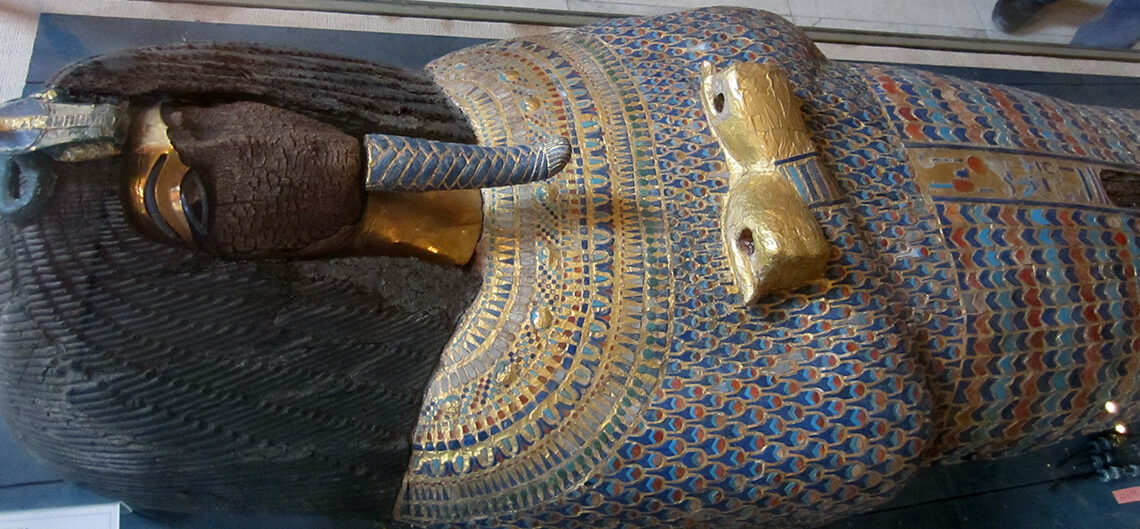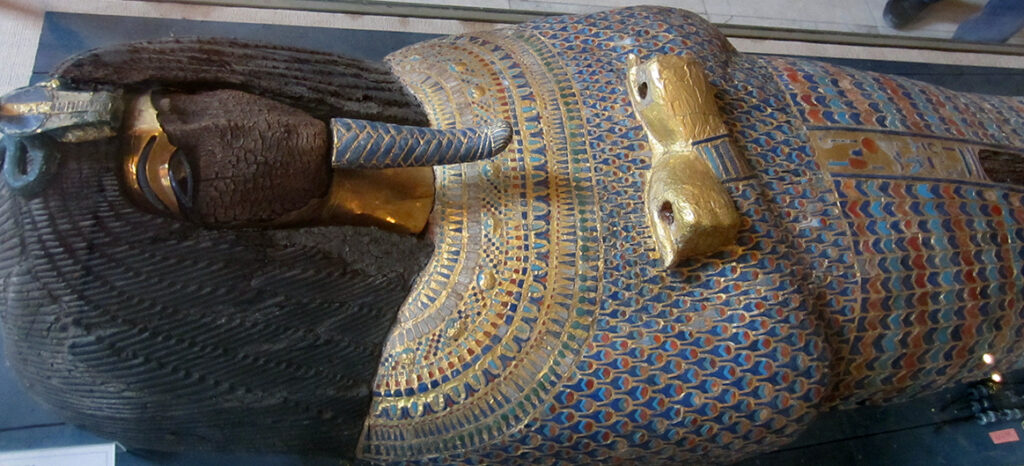Tomb KV55 in Valley of the Kings, Luxor, Egypt – Egyptian Tombs
Secrets of the Egyptian Pharaonic tombs, archaeological discoveries, royal Pharaonic coffins and the mummy discovered inside the tomb to tell us the facts and history of the Pharaonic civilization “Ancient Egypt History” in the civilization of ancient Egypt and the kings of the pharaohs from the era of King Akhenaten, King Tutankhamun and King Amenhotep III, which is considered one of the discovered The Royal Cache of Deir el-Bahri.
Tomb KV55 Facts
It was discovered in 1907 AD by Egyptology and archaeologist Edward Ireton, with full funding from American lawyer Davis..
The entire tomb was robbed and deliberately destroyed, and most of the inscriptions and drawings on the walls were removed by Ancient Egyptian Grave Robbers from the residents of Western Thebes during the Revolutions in Ancient Egypt and the late ages, as a result of the lack of enforcement of the Law in Ancient Egypt and the spread of chaos..
The names of many Egyptian Pharaohs kings and queens of ancient Egypt “Female Pharaohs” were found on the walls of the tomb, Such as King Akhenaton, king Smenkhkare, the young King Tutankhamun, King Amenhotep III and Queen Tiye of the Eighteenth Dynasty of Egypt who lived in The New Kingdom.
Mummy has been discovered whose owner has not been identified yet. It is considered a puzzling mystery and a secret of the secrets of the Egyptian Pharaonic tombs in the Valley of the Kings. It indicates the development of Architecture in ancient Egypt and Sculpture in Ancient Egypt.
Analyses, examinations and x-rays were conducted by researcher Dr. Elliot Smith to identify the mummy and it was discovered that it was of a young man who died at the age of 25..
In 1931 AD, the inscriptions and texts in the hieroglyphic Ancient Egyptian Language on the pharaonic coffin were examined and it was found that they belonged to King Smenkhkare..
In 1957 AD, the Ancient Egyptian Coffins was restored and the texts and drawings on it were studied until it became clear that it belonged to King Akhenaten. “He has the royal Royal Tomb of Akhenaten “Amenhotep Iv” among Tombs of the Nobles Amarna in Tell el-Amarna in Minya.”“.
The most famous Egyptologists, Cyril Aldred, studied and analyzed the mummy discovered in Tomb 55 again. He discovered an enlargement of the lower jaw, which is the same disease that King Akhenaten suffered from, which was a problem with the pituitary gland..
The tomb was carved into the rocks of Mount Qurna..
The ceilings of the cemetery corridor were damaged and worn out as a result of rainwater and floods leaking into the cemetery..
There were deliberate attempts by members of the ruling royal family to remove and destroy the names of the king from the coffin and remove the golden mask (Ancient Egyptian Metallurgy) from the mummy in addition to removing the inscriptions and writings on the pharaonic Egyptian Cartouche located on the golden band surrounding the body of the pharaonic mummy which do not indicate the name of the mummy’s owner..
Archaeologists named tomb No. 55 “Amarna Cache” because the artifacts found date back to the era of King Akhenaten’s rule over ancient Egypt..
Description of the cemetery:
You can reach the entrance door through a stone staircase down..
The seal of the Pharaonic cemetery, “the seal of the Pharaonic tombs,” contains an engraving of the son of Awi holding 9 individuals from the enemies of ancient Egypt..
The tomb contains a blocked rectangular opening believed to be the entrance to the burial chamber..
Behind the walls of tomb 55 is a hall containing stone molds resting on a dilapidated gold-plated chamber with a door with copper hinges above it. Two wooden panels were transferred to The Egyptian Museum in Tahrir Square (Museums in Cairo)“.
On the north side we find the burial chamber containing the gilded royal coffin..
On the other side is a rectangular room with no drawings or engravings on the walls..
Discoveries inside Tomb 55:
Royal Darkness of Wood inlaid with Gold Foil to Show the Development of Industry in ancient Egypt.
3 wooden shrines belonging to King Amenhotep III (He has the Temple of Amenhotep III in El Kab, Aswan, Mortuary Temple of Amenhotep III, and Tomb of King Amenhotep III | KV22 / WV22) covered with gold leaf..
Wooden coffin with gold plated detailing of King Akhenaten.
Bronze snake statue artifact.
“Pharaonic amulets” made of gold and faience, especially for King Akhenaten and others for Queen Tiye.
Wooden statue of King Akhenaten.
4 Canaanite jars for storing the viscera of the mummy’s body inside a small room in tomb 55.
A group of pottery vessels made of faience engraved with the names of Queen Tiye, Queen Sitamun, King Amenhotep III and King Akhenaten..
Limestone pieces engraved with a pharaonic inscription of King Tutankhamun, similar to what was discovered in the Tomb of Tutankhamun | KV62 and King Amenhotep III..
Clay seals containing a royal inscription of King Tutankhamun and wooden pieces inscribed with the names of King Akhenaten and Queen Tiye..
Studies conducted on Tomb KV55:
Skeleton:
There was a big difference between Egyptologists regarding the lineage of the skeleton found inside the tomb, as there was an opinion that it belonged to King Akhenaten or King Smenkhkare, and there was an opinion that it belonged to King Tutankhamun..
Many Egyptologists believe that Queen Nefertiti changed her name to Smenkhkare after the death of her husband, King Akhenaten, to Ancient Egyptian Government.
There is a theory from archaeologist Dr. Theodore Davis that this tomb belongs to Queen Tiye, wife of King Amenhotep III, based on tools that contain an inscription with her name in addition to the heads of a Canubic jar that indicate the shape of Queen Tiye’s face in addition to the discovery of a royal text on the walls confirming that the tomb was built specifically by direct order of King Akhenaten..
There is another theory from archaeologist Dr. Ater Weigall, that the skeleton belongs to a man, King Akhenaten, as the coffin was moved from Amarna to the tomb and all the names and inscriptions related to the reign of King Akhenaten were then disposed of by the priests of the Temple of God Amun “High Priest of Amun” in Thebes at the time..
Dr. Cyril Aldred discovered that the skeleton of King Akhenaten, as a result of examinations, showed that the Pharaoh was suffering from a disease called hyposplenism and a severe disorder in the pituitary gland..
The skeleton was damaged and decomposed as a result of the roof of Tomb 55 falling on the royal coffin, causing the lid to break and damage the royal mummy and its interaction with the outside air, which led to its decomposition..
Dr. Douglas Deary studied the skeleton and skull and proved that it resembles the skull of King Tutankhamun and there is a similarity in the elongation from the back of the head and from the same blood type..
In 1984 AD, the teeth were studied by Dr. James Harris and it was found that the age of death was 35 years..
In 2000 AD, the skeleton was re-examined by Dr. Joyce Filler and it was found that the age of death was 25 years..
It was recently discovered that there is a partial curvature of the spine, which indicates that the age of death is more than 60 years..
The coffin in Tomb KV55:
The royal coffin was examined in 1931 AD and it was found that the inscriptions and hieroglyphic writings belonged to King Smenkhkare..
In 1957 AD, Egyptologist Dr. Sir Ala Gardner examined the inscriptions carefully after the coffin was completely restored and the gold sheets were installed. It was found that the coffin belonged to King Akhenaten..
Note: Facts and secrets of the history Tomb KV55 will be added soon…
Hurghada Excursions Lovers, Best Travel Agency in Hurghada to provide daily tours to visit the Tourist attractions of Luxor by Hurghada to Luxor Tours and Hurghada to Pyramids Trips. Book online when you come to Hurghada, El Gouna, Sahl Hashish, Makadi Bay, Soma Bay, Egypt Tours Packages.
Tomb KV55 In the Valley of the Kings, Luxor, Egypt

